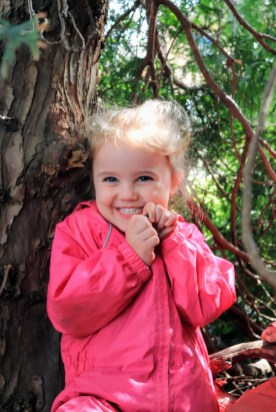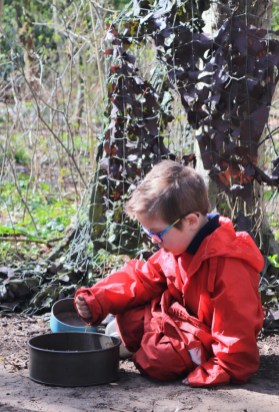Forest School is a fun way of exploring and experiencing the environment through child initiated or child-directed learning.
Forest School allows learning through play and in settings not always previously experienced. There are opportunities to take risks and learn new skills.
Enthusiasm and dedication of the staff encourage children to use their imagination and to have a sense of awe and wonder of the natural world and to be proud of trying new things.
The children are encouraged to investigate & explore but also to respect all living things. Children learn best from first-hand experiences. Exploring, playing and learning using a range of activities (both designed by the leader and instigated by the children themselves) is what forest schools are all about. Building a sense of independence, high self-esteem and teamwork are important parts of forest school, but health and safety considerations are always of paramount importance.
Forest School has been running successfully for several years at Robert Wilkinson Primary Academy. It is led by teacher Miss Blackley.






Progression of skills for Forest School
| Shelter Building | ||
| EYFS | Y1 | Y2 |
| Introduction of basic shelter building with support (some indoor and outdoor equipment)
Mini-den building for small animals Using natural items to create dens e.g. resting twigs/sticks against the bottom of a tree, working as a team with an adult to create a den. |
Supported construction of tripod structures (mini-den building)
Erect a lean to shelter, with support. |
Independent use of tripod structures (animal den building)
Introduction to lashing and frapping techniques to make frames Create a lean to shelter, independently or with limited support |
| Geographical skills and navigation | ||
| EYFS | Y1 | Y2 |
| Follow rules and boundaries
Promote free exploration Use positional language |
Use simple compass directions (North, South, East and West)
Use directional language (near and far; left and right) Describe the location of features and routes on a map Recognise landmarks and human and physical features Devise a simple map and use basic symbols in a key |
Use simple compass directions (North, South, East and West)
Use directional language (near and far; left and right) Describe the location of features and routes on a map Recognise landmarks and human and physical features Devise a simple map and use basic symbols in a key |
| Play/Exploring | ||
| EYFS | Y1 | Y2 |
| Introduction to rules and
boundaries Promotion of free exploration Promotion of independent learning opportunities/skills Show awareness of risk – brambles/nettles/water Carry sticks safely Travel safely over the terrain in Forest School |
Re-enforce rules and boundaries
Travel safely over the terrain in Forest School Work in a team to co-operate and communicate clearly Move logs safely with support first |
Re-enforce rules and boundaries of forest schools
Work in a team to co-operate and communicate clearly Move logs safely |
| Using Tools | ||
| EYFS | Y1 | Y2 |
| Introduction to tools (peelers for whittling, hammers, hand drill, mallets, trowels and forks for planting)
Introduction to using wheelbarrows to transport materials and rakes to sweep leaves. Whittling – peel a stick (with gloves) |
Continuation of the use of basic tools (cutting of string, peeler for whittling, saw to cut discs (1:1)
Whittling – point a stick (tent peg) |
Continuation of the use of basic tools, larger ropes and independent cutting of string
Use of saw 1-1 to cut discs and peelers for whittling |
| Knots | ||
| EYFS | Y1 | Y2 |
| Observe adults tying knots when need arises | Introduction to basic knots | More sophisticated use of knots for attaching to structures and trees
Example – Overhand knot and half hitch Lashing and frapping techniques to make frames |
| Using Fire and Cooking | ||
| EYFS | Y1 | Y2 |
| Observe and talk about fire lighting procedures, begin to contribute by selecting fuel
Safety procedures – fire safety |
Be safe around a fire
Contribute to fire lighting by gathering fuel |
Experience using fire strikers to spark a flame
Light a piece of cotton wool (fairy pillow) Fire safety and the fire triangle |
| Science/Environment | ||
| EYFS | Y1 | Y2 |
| Make observations and drawings of animals and plants in the forest.
Observe changes in the forest e.g. seasonal change/weather Explore different environments. |
Working scientifically –
Ask simple questions. Observing closely, using simple equipment. Identify and classify. Identify and name a variety of common animals. Observe changes across the four seasons Observe and describe weather associated with the seasons and how day length varies. Identify and name a variety of plants, including deciduous and evergreen trees. Identify and describe the structure of a plant, including trees. |
Working scientifically –
Ask simple questions. Observing closely, using simple equipment. Identify and classify. Identify animals and their habitats. Identify and name a variety of plants and animals in their habitats. Construct a simple food chain. Observe and describe how seeds and bulbs grow into mature plants. |
Forest School Uniform
Our Forest School uniform can be found here


